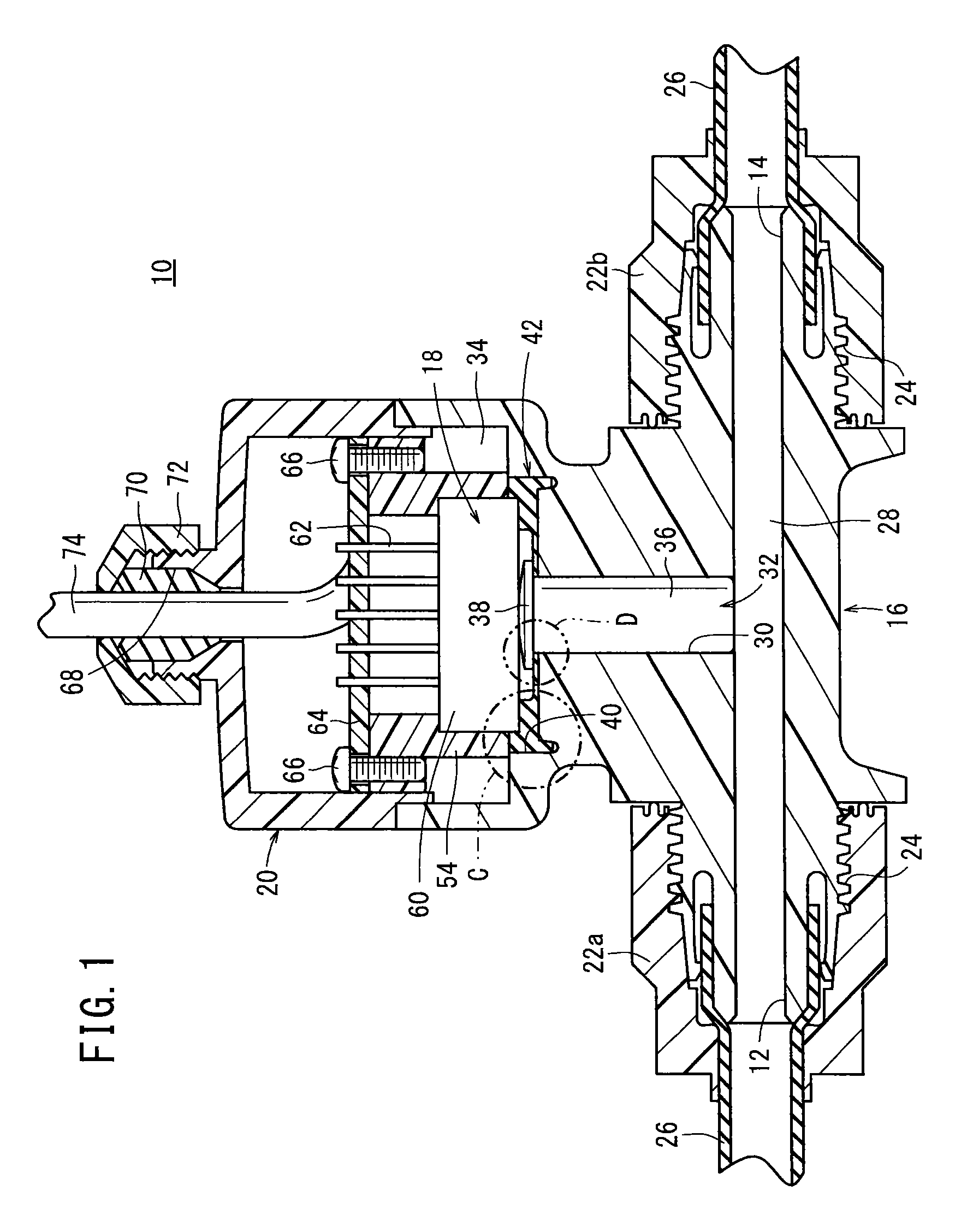Pressure detector
a detector and pressure technology, applied in the direction of fluid pressure measurement using elastically deformable gauges, instruments, mechanical elements, etc., can solve the problems of affecting and affecting the accuracy of pressure detection. , the effect of preventing the degradation of the detection accuracy of pressure sensors due to the temperature of fluid
- Summary
- Abstract
- Description
- Claims
- Application Information
AI Technical Summary
Benefits of technology
Problems solved by technology
Method used
Image
Examples
first embodiment
[0041]The pressure detector 10 according to the present invention basically is constructed as described above. Next, operations and advantages of the pressure detector 10 shall be explained.
[0042]First, in an initial state in which pressure fluid is not flowing through the flow passage 28 of the body 16, since a pressing force from the pressure fluid is not imposed on the lower end of the rod-shaped member 32, the rod-shaped member 32 is not pressed and displaced toward the side of the pressure sensor 18, and the pressure sensor 18 is in a condition of not being pressed by the head 38. Thus, no pressure is detected by the pressure sensor 18.
[0043]Next, when a pressure fluid is supplied to the first port 12 on the upstream side, and the pressure fluid passes through the flow passage 28 and flows to the second port 14, as a result of the pressure of the pressure fluid inside the flow passage 28, the lower end of the rod-shaped member 32 is pressed upwardly, and the rod-shaped member 3...
second embodiment
[0062]In the foregoing manner, with the pressure detector 100 the rod-shaped member 104 of the pressure transmitting body 102 is pressed by the pressure of the pressure fluid that flows through the flow passage 28 of the body 16, whereby the sensor element 60 of the pressure sensor 18 is pressed by the upper end part of the rod-shaped member 104, and the pressure of the pressure fluid is detected. Owing thereto, by inserting the rod-shaped member 104 of the pressure transmitting body 102 in the through hole 30 of the body 16, creation of a dead space in the through hole 30 can be avoided. As a result, pooling of liquid or the occurrence of bacteria or generation of bubbles, which would tend to be problematic if such a dead space were created, can reliably be prevented, and the pressure of the pressure fluid can be detected with high accuracy.
[0063]Further, by using the pressure transmitting body 102 in which the rod-shaped member 104 and the seal member 106 are formed together inte...
third embodiment
[0071]In the foregoing manner, with the pressure detector 120 the rod-shaped member 32 is pressed by the pressure of the pressure fluid that flows through the flow passage 28 of the body 16, whereby the sensor element 60 of the pressure sensor 18 is pressed via the skirt section 124 of the seal member 122, which is abutted by the upper end of the rod-shaped member 32, and then the pressure of the pressure fluid is detected. Owing thereto, by insertion of the rod-shaped member 32 in the through hole 30 of the body 16, creation of a dead space in the through hole 30 can be avoided. As a result, pooling of liquid or the occurrence of bacteria or generation of bubbles, which would tend to be problematic if a dead space were created, can reliably be prevented, and the pressure of the pressure fluid can be detected with high accuracy.
[0072]Further, since the rod-shaped member 32 and the seal member 122 can be formed separately from different materials, ease of assembly of the pressure de...
PUM
| Property | Measurement | Unit |
|---|---|---|
| angle | aaaaa | aaaaa |
| pressure | aaaaa | aaaaa |
| outer diameter | aaaaa | aaaaa |
Abstract
Description
Claims
Application Information
 Login to View More
Login to View More - R&D
- Intellectual Property
- Life Sciences
- Materials
- Tech Scout
- Unparalleled Data Quality
- Higher Quality Content
- 60% Fewer Hallucinations
Browse by: Latest US Patents, China's latest patents, Technical Efficacy Thesaurus, Application Domain, Technology Topic, Popular Technical Reports.
© 2025 PatSnap. All rights reserved.Legal|Privacy policy|Modern Slavery Act Transparency Statement|Sitemap|About US| Contact US: help@patsnap.com



